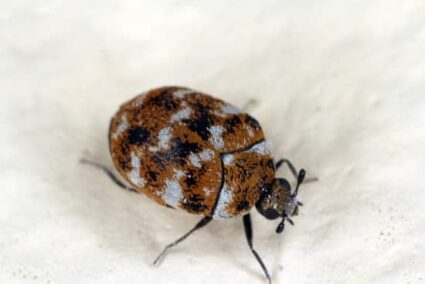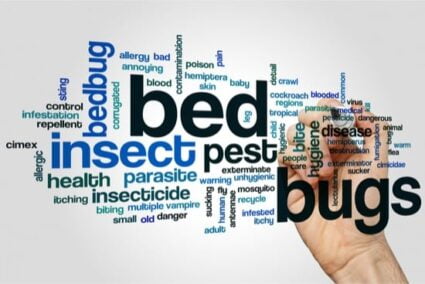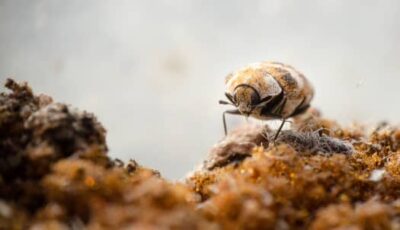You’ve got a bug infestation, but what kind are they? Unless you’ve experienced bed bugs or carpet beetles before, you might not know quite what they look like. You need to be able to tell bed bugs and carpet beetles apart to get rid of the problem.
Bed bugs are a uniform brown, while carpet beetles are mottled brown or shiny black. Carpet beetles are a more rounded shape. Behavior-wise, carpet beetles don’t feed on their host as bed bugs do. Finally, bed bugs prefer to live in mattresses and near your bed, while carpet beetles prefer carpets.
The best way to tell the difference is to get up close. There is no better way. Up close, you can easily tell them apart based on shape and color. But failing that, there are other behavioral clues.
Bed Bugs vs. Carpet Beetles
There are many differences between bed bugs and carpet beetles. It’s fairly easy to tell them apart if you know what to look for, and you can get up close with them. There are also differences in behavior, i.e., where and how they live.
What Do Bed Bugs Look Like?
Bed bugs are small brown bugs that typically live in mattresses and bedding. Their color varies from an almost see-through light brown, which is the color of a nymph bed bug, to a dark brown with hints of red. They look especially dark when they feed. They’re about the size of an apple seed. They have six slender legs, and two small antennae that stick out at right angles from their head.
One of their unique features is the pattern along their back. They don’t have a shell in the same way that carpet beetles or ladybugs do. Their abdomen is long, rounded and flat. It has lines running across it horizontally, from one side to the other. That’s because it’s expandable, so that the bed bug can feed. When they feed, their abdomen gets longer and longer, more and more stretched out.
Here some further advice on how to identify bed bugs.
What Do Carpet Beetles Look Like?
Carpet beetles look like ladybugs, but are different colors. Instead of being red with black spots, they’re a light brown with dark brown/black spots. Their body is a similar shape to ladybugs, in that they have a head section and a large, rounded shell that’s cut in half down the middle.
There are different kinds of carpet beetle, though. The kind described above is the varied carpet beetle. The black carpet beetle is similar, but with a slightly longer body. As the name suggests, it’s black all over, and its shell is shiny. If you’ve ever seen a scarab beetle, they look a little like that (although smaller). Both kinds of carpet beetle are roughly the same size as bed bugs.
A carpet beetle’s head and ‘torso’ (thorax) aren’t as obvious as a bed bug’s. A bed bug has a medium-sized thorax that sticks out from the rest of their body. A carpet beetle’s thorax and head are rounded and better protected than a bed bug’s. That’s because they’re covered by a movable part of their shell, whereas a bed bugs aren’t.

Carpet Beetle vs. Bed Bug Behavior
Aside from the way they look, carpet beetles and bed bugs also behave differently. They eat different things, live in different places, and are drawn to or afraid of different things.
This difference in behavior can be vital in identifying what your infestation actually is. Let’s get started by looking at where carpet beetles and bed bugs like to live.
Where do Carpet Beetles Live?
Carpet beetles don’t live in beds in the same way that bed bugs do. As their name suggests, they like to live in carpets, partly because they can feed on carpet fibers and dust. But they can also live almost anywhere around the house, including:
- In wardrobes, feeding on the fabric in clothing
- In attics and basements, where they might find dead birds and their nests
- Corners of each room, where they might find dead spiders and other insects
- Around the base of beds or sofas, especially those that are upholstered (i.e., covered in fabric)
- Discarded clothes which aren’t picked up for a while
So, while they can live in and around your bed, they don’t prefer living there like bed bugs do. If you see a few bugs in your bedding, but there are also lots elsewhere in the room, then they’re likely carpet beetles rather than bed bugs.
Where do Bed Bugs Live?
Bed bugs don’t normally live in carpets. They prefer being somewhere that’s difficult to access, where they can hide and digest their meal in peace. The only exception is if there’s a small gap between the carpet and the wall, in which case they might try and live there. But they’ll only pick a place like that if there’s already a large infestation, and no more room underneath your mattress.
You also won’t see them scuttling across carpets, like you might with carpet beetles. Bed bugs aren’t sprightly and agile, they’re unwieldy and find it difficult to crawl through things like hair or fur.
Plus, they don’t like being out in the open during the daytime. As such, if you see a beetle crawling across the carpet during the day, it’s not likely to be a bed bug. It’s much more likely to be a carpet beetle or something similar. So, rather than in the carpet, a bed bug would prefer to live:
- Underneath your mattress, especially near the piping around the edge
- In cracks around your room, like in the walls or the floorboards
- Underneath furniture, especially furniture that’s near your bed, but also your couch
Bed bugs want to live within six feet of wherever you sleep. They can get to you easily to feed. Any further away and they might have trouble finding you, or they might get picked off by a pet, or killed by someone else in the house. As such, they’ll primarily live near your bed.
Do Carpet Beetles Bite?
Carpet beetles and bed bugs feed on different things. Bed bugs feed on humans. We’re their hosts, and they live in our bedding so that they can bite us while we’re asleep to feed on our blood. But carpet beetles don’t. They have a wide diet that consists mainly of animal products. They’ll eat:
- Dead skin, but not living skin
- Fur, hair, and feathers
- Wool
- Dead insects
- Non-animal fibers, including cotton and synthetic fibers
As you can imagine, they can find plenty of these food sources in your carpet. This leads to one of the biggest differences between bed bugs and carpet beetles.
If you have a bed bug infestation, you’ll notice that you wake up with sore spots where they’ve bitten you. These spots will be inflamed, like a mosquito bite, and they’ll itch terribly.
But since carpet beetles don’t bite, you won’t wake up with spots like these.

Are Carpet Beetles Harmful?
So, carpet beetles can’t bite you. That means they’re completely harmless then, right? Wrong.
Having an allergic reaction to carpet beetles is possible. They don’t bite. But their tiny hairs can cause spots to form. This occurs on contact, so there’s a chance that either you touched a carpet beetle or that one crawled on your skin if you see these spots.
Larvae, especially, are covered in long hairs sort of like the hairs on a nettle. When one of these hairs comes into contact with your skin, it can break off and leave an itchy, irritated spot.
It’s not unlike the kind of spot you get when you’re bitten by a bed bug, funnily enough. According to a paper in the Journal of the American Academy of Dermatology, getting rid of your carpet beetles will get rid of your spots.
It’s easy to tell these spots apart from bed bug bites. When bed bugs bite, they typically bite in small clusters or lines. That’s because several bed bugs feed throughout a night.
If you have a larger infestation, fresh bites will appear regularly. With carpet beetle spots, though, you’re only going to get them if one of the bugs actually crawls on you. As you can imagine, this occurs much less frequently.
Besides that, carpet beetles are harmful to your clothes, furnishings, and carpet. They eat fibers, so they can leave your carpet threadbare and create holes in all your clothes. This isn’t harmful, but it is damaging, and can cost you money if you have to replace your carpet or your things.
Do Bed Bugs Bite?
Bed bugs feed entirely differently. As you know, they feed on their host’s blood. They’ll sneak up on you during the night, and feed for fifteen or twenty minutes. They’ll then head back to their hiding place (called a ‘harborage’), where they’ll digest their meal for days. The bite mark will become a nasty lump, because of the body’s allergic reaction to bed bug saliva.
Bed bugs can’t feed on anything but blood. So, if you know that you’re being bitten by your infestation, it’s bed bugs and not carpet beetles.
Can Bed Bugs Fly?
Bed bugs can’t fly. They don’t need to, because they live in bedding. To get around, they rely on their host carrying them places, and on communal beds, i.e., hotel beds.
They did evolve from a creature with wings, though. You can tell because they have tiny stubs which used to be the muscles that controlled their wings. But over time, as they developed the need to hide in cracks and crevices, bed bugs without wings had an advantage over those that did. Over time, the bed bugs that evolved flatter bodies with no wings were more successful.
Can carpet beetles fly? Yes, they can, and it’s a common way for them to infest homes. Their shells are bisected along the middle because their shell can fold outwards like a ladybug.
Underneath their shell is their wings. Because they live in nature as well as in our homes, they have more need to fly, to get from one food source to another or to escape prey. So if you notice that the insects infesting your home can fly, then they’re carpet beetles, not bed bugs.
Do Other Bugs Look Like Bed Bugs?
Aside from carpet beetles, there are other kinds of bugs that look a little like them. The first is larder beetles, which look like black carpet beetles. They have hairy larvae which look just like the carpet beetle’s, too.
The main difference is that they’re a little longer, with a brown midsection with dark spots. They have more pronounced heads than carpet beetles, like bed bugs. The rest of their body is dark brown-black, and their shape is rounded like the carpet beetle.
Larger cabinet beetles look like larger versions of the varied carpet beetle. They have a shiny shell that’s a mottled brown color. Aside from these bugs, if you don’t know much about insects, then you could probably confuse any bug with a bed bug. Some people don’t even know the difference between dust mites and bed bugs before they do their research.

If you’re not sure what’s infesting your home, the solutions are often the same. Passive traps that work on bed bugs work on carpet beetles too, for example. Insecticides that kill bed bugs will also kill carpet beetles, larder beetles and more. As such, it’s not always important to learn how to tell the difference.
But if you still want to know what the infestation is, try and catch a bug and bag it. Then compare it to pictures of each kind of bug you find online. You should be able to tell for yourself what it is. Failing that, talk to a pest control operative and they should be able to tell you. You can even show them the bug. They’ll usually be able to tell you right then and there what it is.
Can You Have Carpet Beetles and Bed Bugs Together?
You can most definitely have carpet beetles and bed bugs infesting your home at the same time. Having bed bugs makes it slightly more likely that you’ll have carpet beetles too.
That’s because carpet beetles eat other dead insects, so if there are plenty of dead bed bugs around, that might help a carpet beetle infestation take hold.
However, there’s a common misconception related to how you ‘catch’ bed bugs and carpet beetles. It’s nothing to do with having a dirty house, and is more to do with luck than anything else.
How Common are Carpet Beetles in Homes?
Carpet beetles are common across the country. While bed bugs were almost exterminated a few decades back through pesticide use, carpet beetles weren’t.
That’s because they’re equally happy indoors and out. So even if we could kill every carpet beetle in every home, they could still come back.
As for how many people they affect, there aren’t any figures to draw from. Bed bugs tend to be more common in cities, because that’s where most of the people and hotels are. Carpet beetles are common all around the country, because they don’t rely on travelers spreading them.
What Causes Carpet Beetles?
They aren’t attracted to untidy homes, although untidiness can help them flourish. Carpet beetles actually come from the outside, and are usually brought in along with flowers or similar.
Alternatively, they may just come through the attic or crawl space from the outside. But whether your home is tidy or clean doesn’t have an effect.
Once there are some carpet beetles in your home, they form a self-sustaining infestation. They’ll feed on dead skin and fibers, breed, and create the next generation. They’ll keep going until you get rid of them.
Bed bugs are similar in that they have to be brought in to your house. Perhaps you sat on a couch in somebody’s house that had bed bugs in it. Or, perhaps a guest brought them in with them.
Either way, what we’re trying to say is that ‘catching’ bed bugs and then ‘catching’ carpet beetles is possible, but they aren’t connected events.
How to Get Rid of Carpet Beetles and Bed Bugs
So, now that we know the difference between carpet beetles and bed bugs, is there a difference in how you can get rid of them? You can get rid of carpet beetles and bed bugs in the same ways.
How to Get Rid of Carpet Beetles
Getting rid of carpet beetles is easier than getting rid of bed bugs. Carpet beetles aren’t as good at hiding as bed bugs are, and since they’re out in the open most of the time, they’re easy to spot and catch. Start by vacuuming the carpet thoroughly, as well as any furniture that can be vacuumed.
Repeat this process daily for a week. After each time you vacuum, empty the contents of your vacuum cleaner in an outside trash can so that the bugs inside can’t re-infest your home.
If the infestation is particularly serious, you may need to take more drastic steps. If the clothes in your wardrobe are full of holes, bag them securely and dump them directly in the washing machine. Launder them at a high temperature, as this combined with the water is guaranteed to kill both carpet beetles and larvae/eggs.
Finally, set traps to lure them in. These traps contain pheromones (chemicals) that lure carpet beetles towards them. These will draw out any carpet beetles you didn’t manage to vacuum.
If you still find beetles after you’ve tried all this, you will need to use an insecticide spray. Follow the instructions on the spray to the letter a) to ensure that you kill every carpet beetle, and b) to prevent side effects.
How to Get Rid of Bed Bugs
Getting rid of bed bugs is broadly similar to how you kill carpet beetles. There are two approaches to take. The first is to physically kill them and prevent them from reaching you at night. Methods that fit this description include:
- Purchase a mattress encasement. This wraps around your mattress to stop bed bugs getting in and out. Since most bed bugs live in the mattress, this should halve the problem at least.
- Physically killing bed bugs by laundering them.
- Using either traps or lures to catch any remaining bed bugs. You can use basic plastic traps that they can’t crawl out of, or ‘active lures’ which give off heat and CO2.
- Using a vacuum cleaner won’t kill them, but it can collect them. If you want to, use the same method described above. Just make sure to empty your vacuum cleaner after each use.
You can also try sprays that repel or directly kill bed bugs. There are all kinds of sprays available, from synthetic ones (containing permethrin or pyrethroids), to natural ones made from essential oils or even funguses that only affect insects. These sprays don’t just kill bed bugs, but repel them too. To kill bed bugs, the best method is a combination of using a mattress encasement and sprays.

